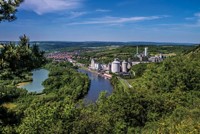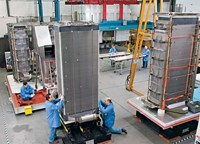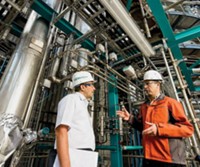Advertisement
Grab your lab coat. Let's get started
Welcome!
Welcome!
Create an account below to get 6 C&EN articles per month, receive newsletters and more - all free.
It seems this is your first time logging in online. Please enter the following information to continue.
As an ACS member you automatically get access to this site. All we need is few more details to create your reading experience.
Not you? Sign in with a different account.
Not you? Sign in with a different account.
ERROR 1
ERROR 1
ERROR 2
ERROR 2
ERROR 2
ERROR 2
ERROR 2
Password and Confirm password must match.
If you have an ACS member number, please enter it here so we can link this account to your membership. (optional)
ERROR 2
ACS values your privacy. By submitting your information, you are gaining access to C&EN and subscribing to our weekly newsletter. We use the information you provide to make your reading experience better, and we will never sell your data to third party members.
Environment
Chemicals To Help Coal Come Clean
Scrubbing methods to capture carbon from power plants are advancing to the demonstration phase
by Ann M. Thayer
July 13, 2009
| A version of this story appeared in
Volume 87, Issue 28

By capturing carbon dioxide emitted from coal-fired power plants and storing it in underground geologic formations, power generators believe they can continue to use the plentiful fossil fuel while reducing greenhouse gas emissions. Accomplishing this feat will not be easy, but chemical companies and other technology providers are lining up to help.
Coal already accounts for 40% of global power generation, and it is expected to play an even larger role as energy needs rise, according to the International Energy Agency, an intergovernmental policy adviser. IEA and other agencies have identified carbon capture and storage (CCS), at least in the short-term, as a promising approach to reducing emissions.
As a result, governments around the world have recently pledged billions of dollars for R&D and expensive CCS demonstration projects. In 2008, the G-8 nations (Canada, France, Germany, Italy, Japan, Russia, the U.K., and the U.S.) set a goal of having 20 such demonstration projects in play by 2010 and broad commercial deployment by 2020.
The consulting firm Emerging Energy Research estimated earlier this year that more than $20 billion has been earmarked for spending and predicted that more was to come from economic stimulus plans. Last month alone, the U.S., Australia, Canada, and the European Union announced a total of more than $6 billion in funding. All told, the firm says, there's enough money to support about 30 large-scale CCS demonstration projects.
Meanwhile, legislative moves, such as the climate bill passed last month by the U.S. House of Representatives, are expected to set limits, and a value, on greenhouse gases (C&EN, June 15, page 22). Carbon caps and pricing are considered critical for creating a market by making the value of CO2 emissions avoided more than the cost of adding the CCS process.
"Right now, the only market around the world is government-funded projects," says Peder Danielsen, marketing director for Dow Chemical's oil and gas business, which offers an amine-based technique for stripping out CO2. Until the gap between CCS costs and carbon credits closes, "nobody is going to build a system unless they have government funding," he remarks.
Plenty of funding is out there, and a growing number of partnerships are advancing carbon-capture projects. Implementing CCS technology, however, will require proof that it works and can be cost-effective at large scale.
Capturing and compressing the CO2 accounts for about two-thirds of the cost of CCS, according to the consulting firm McKinsey & Co. For early commercial-scale plants, expected by 2020, "we are looking at a cost between $50 and $70 per ton of CO2 abated, and there are very few projections that put the price of carbon above $50 to $60 per ton," says Enrico Villa, a McKinsey analyst. Nearer term demonstration projects will likely cost as much as $80 to $130 per ton.
Developers betting on CCS are looking down three separate paths: oxy-fuel processes and pre- and postcombustion CO2 capture. Oxy-fuel and precombustion coal gasification are targeted at new power plants. In contrast, postcombustion scrubbing, typically using alkanolamines or ammonia, can be retrofitted onto existing plants, of which there are many. Scrubbing technology is well-known; for decades Dow, BASF, and others have supplied amine-based processes to clean up high-pressure, CO2-rich natural gas streams.

To clean up the flue gases from coal-fired power plants, however, the scrubbing technology must be optimized to work at low pressures on large gas volumes that contain only 10–15% CO2. In the process, flue gas is exposed to an aqueous solution containing a weak base—often mono- or diethanolamine less than 30% by weight—that absorbs the weakly acidic CO2. Subsequent heating strips the CO2. The solution is recycled, and the CO2 is captured and compressed for transport and storage.
Although about 90% of a power plant's CO2 can be captured, a major drawback is that the process consumes energy itself. Estimates are that a full-scale plant would have to generate as much as 30% more power to cover the energy drain of capturing and compressing the CO2. Not only would more coal have to be burned, but the increased operating and capital costs would raise electricity prices.
BASF and its partners, the German electricity producer RWE Power and the engineering firm Linde, are working to ensure "state-of-the-art integration" of the carbon-capture process into a power plant to minimize the penalty on electrical output, explains Andreas Northemann, head of the gas treatment solutions team in BASF's intermediates division.
"We aim to develop a process that costs less than $35 per ton of CO2 avoided," he says, referring to CO2 capture and compression but not sequestration. "As soon as it is clear that the technology has proven itself, and policy sets the right course, we see good chances for substantial market growth."
To put the technology through its paces, the team is building a pilot plant at RWE's power station in Niederaussem, Germany, at a cost of about $13 million, 40% of which will come from the government. The plant will scrub just 0.05% of the flue gas from a 1,000-MW power plant and capture about 300 kg of CO2 per hour. If successful, a much larger $100 million demonstration unit will follow in 2010. Full-scale operations are targeted by 2015, according to RWE.
BASF's main goal for the pilot project is testing new solvents and solvent mixtures in large equipment. Like Dow, BASF declines to offer any details about its proprietary solvents, saying only that its "advanced amine" system will have lower operating costs than standard amine technology. Some projects are said to be combining mixed or hindered amines that use less energy with additives, such as piperazine, that boost CO2 absorption rates.
CCS developers face complex calculations involving capital and operating costs. "The big issues are how much steam do you consume for stripping and how much electricity do you need for compression?" Danielsen says. "We have done a tremendous amount of simulation work trying to figure out how to optimize the plants." The next step for Dow is confirming these analyses in projects with Alstom, a French power plant builder.
Soon, the partners will take a live flue gas slipstream from Dow's coal-fired power plant in South Charleston, W.Va., and run it through a pilot unit. It will allow them to capture about 1,800 tons of CO2 per year. They have also agreed to build an amines demonstration facility at a power station in Belchatow, Poland, that will capture about 72,000 tons of CO2 per year by mid-2011. A second phase would add a CCS unit to an 858-MW power plant being built there by 2015. Dow is looking for other sites to host projects as well, Danielsen says.
Separately, Alstom has several projects under way to test its chilled ammonia process. Similar to the process using amines, flue gas is exposed to an ammonium carbonate solution at about 35 °F that absorbs the CO2 to form ammonium bicarbonate. Heating the mixture causes the bicarbonate to revert to the carbonate form, which is recycled, while the CO2 is captured.
Data reported in May from an Alstom ammonia project at We Energies' power station in Pleasant Prairie, Wis., showed that 88–90% of the CO2 emitted was captured at greater than 99% purity. Alstom is bringing an ammonia project on-line at American Electric Power's Mountaineer power station in New Haven, W.Va., that will capture 110,000 tons of CO2, compress it, and store it 8,000 feet belowground. If successful, the partners plan to install the technology at a commercial scale, capturing at least 1 million tons, by as early as 2012.
With $50 million raised in April from investors, the private company Powerspan is scaling up its own ammonia process, originally developed with the Department of Energy, at Basin Electric's Antelope Valley Station in North Dakota. Expected on-line in 2012, the 120-MW demonstration project will capture 1 million tons of CO2 per year that will be compressed and fed into a pipeline for use in enhanced oil recovery. Powerspan is also running a pilot-scale system at FirstEnergy's R.E. Burger power plant, in Ohio.
In addition, Powerspan is among three finalists whose technology is being evaluated by the Canadian utility SaskPower for a $1.4 billion CCS demonstration project in Estevan, Saskatchewan. The others are Cansolv Technologies, a Shell company that offers an amine-based process, and the engineering company Fluor, which offers the Econamine process, based on technology acquired from Dow in 1989. SaskPower will decide on a process by the end of 2009.
In any scrubbing process, CO2 capture usually occurs after the removal of nitrogen oxides, sulfur dioxide, and other flue gas components that can degrade the solvents and reduce the efficiency of the process. In Powerspan's case, its CO2 process is integrated with its ammonia-based ECO technology for removing other pollutants.
Although Powerspan's method involves handling volatile ammonia, which is often generated on-site from urea, it is more tolerant of sulfur and less corrosive to equipment than amines, says Christopher McLarnon, senior vice president for engineering and R&D at Powerspan.
Another benefit is that the amount of heat required to regenerate the ammonia solution is less than one-third of that needed in the amine process, McLarnon says. "In all of these processes, heat management is very important, and you can save quite a bit of energy with the ammonia process."
Building on more mature CO2 capture methods, Ion Engineering, a University of Colorado spin-off, is combining commercially available amines with thermally stable, nonvolatile ionic liquids. "Water is responsible for a lot of the inefficiency of the capture process," says Alfred Brown, the firm's chief executive officer. A significant amount of energy—two to three times that used to strip the CO2 from the amine—is lost just due to water evaporation. "We don't change the overall engineering of the system significantly, just the physical solvent," he points out.
Ionic liquids are among a range of new technologies, including membranes, metal organic frameworks, and other absorbents, being explored for carbon capture. Other research groups, including some working under DOE grants, have been experimenting with amine-functionalized ionic liquids. But simply mixing the ionic liquids and amines avoids having to synthesize functionalized ones, which tend to also be very viscous, says Jason E. Bara, an Ion founder and the company's chief technical officer.
Because of its overall efficiency, Ion's system needs less expensive equipment, the company claims. Although ionic liquids are pricier than water, they can be modified to work under different conditions and with different amines. Ion can reduce the capture portion of the equation, including the cost of the ionic liquids, to about $20 per ton, or a savings of about 65% compared with estimates for large-scale aqueous systems, Brown says.
Having conducted lab-scale work, the company is finalizing a partnership with a major utility company to field-test its approach, Brown says. A pilot project under design will capture flue gas from the equivalent of a 1-MW power plant. "If we are successful with that, the intent clearly is to go to a demonstration stage at the 40- to 50-MW scale and from there to full commercial operations," he says.
Technology developers all anticipate that the CCS market will eventually be large. In preparation—and despite the unknowns in timing, pricing, and regulations—Dow is investing heavily, Danielsen says. Many challenges remain, however, not the least of which are the downstream issues of transporting and successfully storing the captured CO2.
"At the R&D level and all the way through the demonstration scale, carbon capture is here today," Brown says. "There is no shortage of people who want to do pilot and demonstration projects, and it is almost certain that it will take some federal funding to get through those stages. But I am very encouraged because there are technologies like ours where the economics suggest that it is much more affordable to capture CO2 than was previously thought."





Join the conversation
Contact the reporter
Submit a Letter to the Editor for publication
Engage with us on Twitter